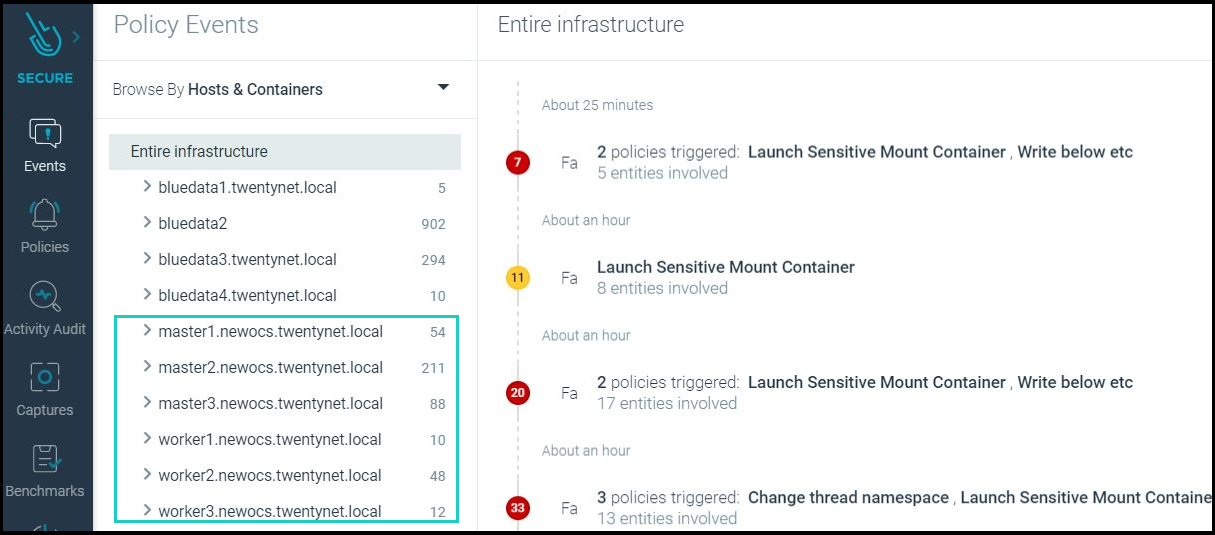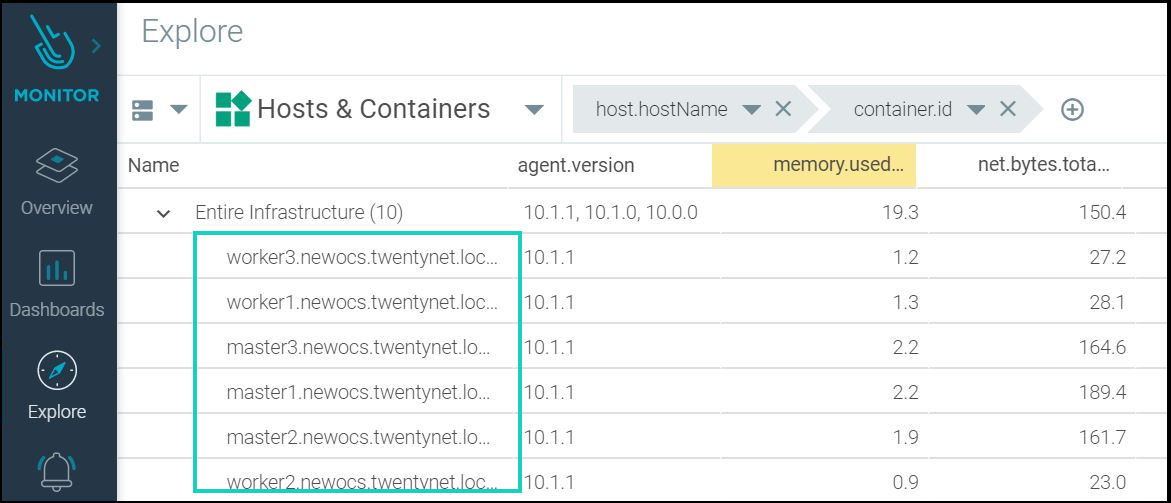# Securing Red Hat OpenShift Container Platform using Sysdig Secure and Sysdig Monitor
# Description
This section contains Ansible playbooks to automate the installation of sysdig agents over the Red Hat OpenShift 4.9 Cluster. The contents of the repository includes the playbooks and input files as listed.
- playbooks: This folder contains the playbook required for Sysdig agent installation over OCP 4.9.
- roles: This folder contains a role called “sysdig-agent-deploy-ocp” which is responsible for performing the actions required for Sysdig agent integration.
- hosts: This is the host file which will be used by Ansible installer machine to reference localhost during Sysdig agent deployment.
- secrets.yml: This file contains sensitive information about the Sysdig SaaS platform access details and Red Hat OpenShift cluster access details.
Prerequisites
Ansible engine with Ansible 2.9.x and Python 3.6.x.
Red Hat OpenShift 4.9 is up and running.
User has SaaS-based access to Sysdig Secure and Sysdig Monitor for the purpose of container security.
User has “admin rights and privilege” for Sysdig Secure and Sysdig Monitor.
User has valid access token that is given by Sysdig and is specific to their credentials on Sysdig SaaS platform.
User has updated the kernel to ensure that all the nodes have same kernel version. Information regarding this can be found by logging into Sysdig monitor account. Go to setting and under Agent Installation, you will find instructions to install the kernel headers.
Enable password-less ssh from OpenShift installer machine to itself (OpenShift installer machine or localhost).
- Create password-less ssh to installer VM by generating the ssh key.
$ ssh-keygen
NOTE
Press enter to overwrite the id_rsa.pub file and also press enter for empty password.
Copy the ssh key to ~/id_rsa.pub file using following command
$ ssh-copy-id -i ~/.ssh/id_rsa.pub nonrootusername@ansible_engine_machine_ip
# Software requirements
| Software | Version |
|---|---|
| Sysdig SaaS Agent | 10.1.1 |
# Input files
- Playbook for Sysdig SaaS integration with RedHat OpenShift Container Platform are available under $BASE_DIR/platform/security-sysdig/
NOTE
BASE_DIR is defined and set in [installer machine] section in deployment guide.
- It is mandatory to update all the input files (hosts, secrets.yml, sysdig-agent-configmap.yaml) with appropriate values before running the playbook available in this repository.
- Input file name - hosts
- This file is an inventory of host details.
- This file is available under $BASE_DIR/platform/security-sysdig/.
- Specify the Ansible engine machine IP as the value of the variable.
[ocp_installer_machine_ip]
- Input file name - sysdig-agent-configmap.yaml
- This file is available under $BASE_DIR/platform/security-sysdig/roles/sysdig-agent-deploy-ocp/files/.
- Provide the Sysdig SaaS Platform Address and Port Number along with Red Hat OpenShift cluster name to the variables as listed :
collector: <sysdig_saas_collector_address>
collector_port: <collector_port>
k8s_cluster_name: <replace_with_ocp_cluster_name>
Input file name - secrets.yml
This file is available under $BASE_DIR/platform/security-sysdig/.
Provide value of project name for Sysdig integration with OpenShift Container Platform. This project will be created in OpenShift.
Provide the access key or token value. You must get this value from user setting by logging into either Sysdig Secure or Sysdig Monitor GUI.
Provide Red Hat OpenShift username and password to login.
projectname: <sysdig_project_name>
accesskeyval: <sysdig_saas_access_key>
ocpuser: <RedHat_OpenShift_User_Name>
ocppassword: <RedHat_OpenShift_User_Password>
Input file name - sysdig-agent-deployment.yaml
This file is available under $BASE_DIR/platform/security-sysdig/playbooks/
Update the KUBECONFIG and oc command path.
KUBECONFIG: <replace_with_kubeconfig_path> PATH: <replace_with_ocp_installation_dir_path>:{ ansible_env.PATH }
# Procedure to deploy automated Sysdig SaaS agents on Red Hat OpenShift Container Platform cluster
Execute the following commands from the Ansible installer VM in the python virtual environment as a non-root user.
$ cd $BASE_DIR/platform/security-sysdig/ $ ansible-playbook -i hosts playbooks/sysdig-agent-deployment.yaml --ask-vault-pass
NOTE
BASE_DIR is defined in [installer machine] section in deployment guide.
Verification of Sysdig agent deployment on Red Hat OpenShift cluster nodes after successful execution of the playbook. Run the command listed below to get the information on Sysdig pods..
$ oc get pods | grep sysdig-agent
Output of the above command should show you all Sysdig pods in running state.
sysdig-agent-2ljgw 1/1 Running 0 42m sysdig-agent-cdxtc 1/1 Running 0 42m sysdig-agent-frr7k 1/1 Running 0 42m sysdig-agent-gkcmk 1/1 Running 0 42m sysdig-agent-pzrvr 1/1 Running 2 42m sysdig-agent-qv6qh 1/1 Running 0 42m
NOTE
Number of sysdig pods should be equal to number of nodes that user sees after running the following command:
$ oc get nodes
Output of above command shows number of nodes in the Red Hat OpenShift cluster.
NAME STATUS ROLES AGE VERSION master1.newODF.twentynet.local Ready master 64d v1.17.1 master2.newODF.twentynet.local Ready master 64d v1.17.1 master3.newODF.twentynet.local Ready master 64d v1.17.1 worker1.newODF.twentynet.local Ready worker 64d v1.17.1 worker2.newODF.twentynet.local Ready worker 64d v1.17.1 worker3.newODF.twentynet.local Ready worker 64d v1.17.1
NOTE
If you see a pod in pending state, then there might be a possibility that the underlying OpenShift Container Platform node is not functional.
- Verification using Sydig GUI
Login to Sysdig Secure and under Policy Events –> Hosts and Containers –> user will find all the nodes that are part of your Red Hat OpenShift infra and this shows Sysdig agents are successfully installed and security checks are being run on all those nodes.
 Figure 30 - Securing Red Hat OpenShift cluster nodes using Sysdig Monitor GUI
Figure 30 - Securing Red Hat OpenShift cluster nodes using Sysdig Monitor GUILogin to Sysdig Monitor and under Explore –> Hosts and Containers –> user will find all the nodes that are part of your RedHat OpenShift infra and this shows Sysdig agents are successfully installed and monitoring on all those nodes.
 Figure 31 - Monitoring Red Hat OpenShift cluster nodes using Sysdig Monitor GUI
Figure 31 - Monitoring Red Hat OpenShift cluster nodes using Sysdig Monitor GUI